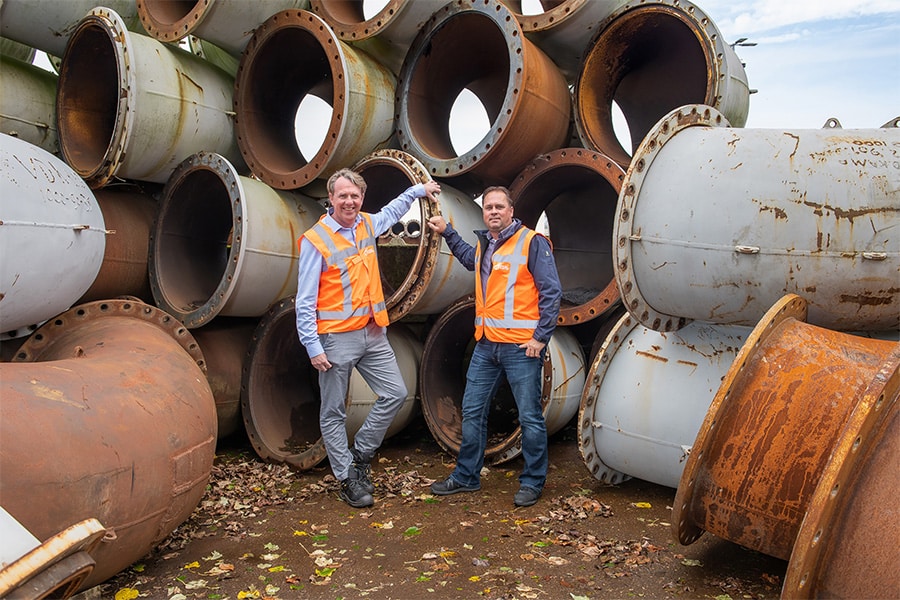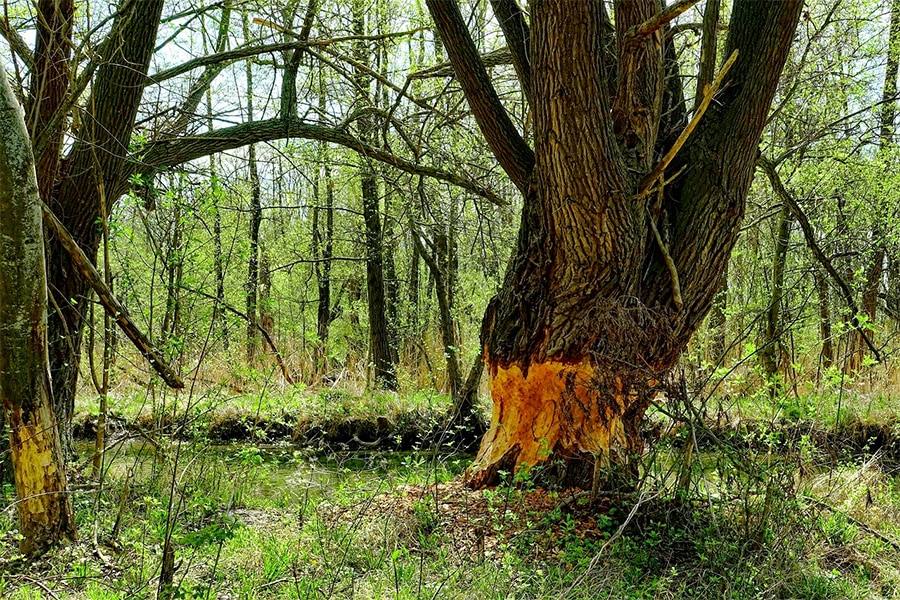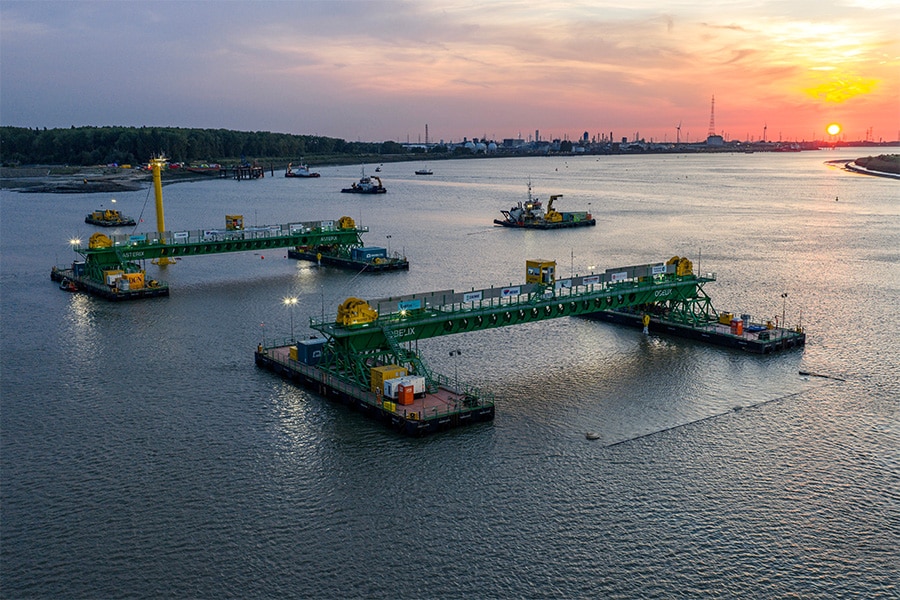
Capturing 36 million cubic meters of water: how do we do it?
Additional measures needed for 's-Hertogenbosch delta site to prevent flooding
Flooding like in Limburg (summer 2021) is also possible around 's-Hertogenbosch. What is being done to prevent it? The water boards Aa and Maas and De Dommel are joining forces. Together with partners they are working on a package of measures. A strategy has been outlined including concrete solution options. In this article you can read what is happening and how work is being done.

The working area of both water boards totals some 240,000 hectares and covers a large part of central and eastern Brabant. 's-Hertogenbosch is the lowest point (about 40 meters lower) and thus acts as a "drain"; all the water from streams and rivers wants to go this way.
Marit Borst, Director De Dommel Water Board: "If you look at the map of the catchment area from above, you can clearly see that 's-Hertogenbosch lies in a delta. All main and side streams converge here and are then discharged into the Maas (via Crèvecoeur sluice and the Bovenlandse lock - ed.). Under normal circumstances, this can be done without any problems. The Meuse can also be discharged in case of heavy precipitation. Problems arise with a combination of heavy precipitation (and thus large discharge from the regional water system) and a high Meuse water level. In that situation, there is insufficient or no discharge and the water level at 's-Hertogenbosch rises too high, causing flooding. In extreme situations, this leads to flooding."
Flooding Limburg: clear warning
What happened in Limburg in 2021 is also possible around 's-Hertogenbosch. Due to the high water level of the Meuse in 2021, the Geul stream could no longer discharge the excess water into the river and overflowed with dramatic consequences. Marit: "A similar situation occurred in 1995 around 's-Hertogenbosch. After a wet December month it continued to rain steadily in January. The Maas rose sharply and so did the water in the catchment areas of the Dommel and the Aa. Excess water could no longer be drained through the Meuse and the soil was also saturated. The result was a major flood that flooded the A2 motorway, one of the country's main traffic arteries, among others."
Then the HoWaBo (Hoogwateraanpak 's-Hertogenbosch) project was started. The water boards Aa and Maas and De Dommel started working on solutions in close consultation with surrounding municipalities (Sint-Michielsgestel, Boxtel, Heusden, Vught and 's-Hertogenbosch), the province of North Brabant and Rijkswaterstaat.
For example, large water storage areas have been established where a total of 14 million cubic meters of water can be stored in times of emergency.
New (climate) calculations show that the current collection in the Aa and Dommel river basin is insufficient. That is why the cooperation project was revived two years ago. The main task now is to find additional space for another 30 to 40 million cubic meters of water. It is even expected that towards 2050 the required capacity could rise to 50 million cubic meters. This not only involves measures around 's-Hertogenbosch and neighboring municipalities, but also further upstream in the higher region. Hence the abbreviation HoWaBo now stands for: Flood Approach Brabant East.

Not everything is manufacturable anymore
We are increasingly facing fierce peak showers and sudden flooding due to climate change. Marit on the measures: "We have to reckon with unprecedented water bombs. See Limburg. Doing nothing is not an option. With a mix of measures we will have to adapt our water system. For example by collecting water upstream, where the drop falls. Everything you store there, you don't have to collect downstream. In this way you slow down the water nuisance that comes to 's-Hertogenbosch. About 10% of the problem can be absorbed with this. So there are many more measures needed this way."
The task is large and complex. Not only because of the serious consequences of possible flooding and the many interests involved, but also because of the type of measures. For example, additional water storage facilities three times the size of the current ones are needed. Huge sums of money are also involved, including for possible additional pumping station capacity.
According to Marit, we need to get rid of the idea that everything is technically engineerable. "Over the past century we have started to regulate the water system more and more. Not too much or too little water per season. Together with partners, we have tried to bend nature to our will by controlling the water. Climate change makes it clear that this approach is no longer tenable. We will have to move more with nature and learn to live with water. And accept, for example, that certain areas may be flooded. We will have to follow the logic of the landscape much more. Is an area low? Then it is logical that it will be wet there more often. Moving with the natural process is essential for a future-proof water system."
HoWaBo project manager Ingrid Rijkers emphasizes that high-water measures cannot be separated from other pressing issues such as nitrogen measures and housing shortages. "That requires difficult choices, because many measures require space, and space is scarce. After all, we also want to build houses, roads and nature. That requires smart combining and good cooperation. No matter how different the interests are, cross-connections will have to be made wherever possible."

Different view of water
According to Ingrid, we will have to look at water in a different way. "It's not about a few technical solutions and that's it. It's a complete transition. But calling it a transition also makes it sound like it's about a change that might take decades. And that, of course, is not possible with flood risk. Action is also needed in the short term."
Ingrid on the complexity: "The task involves various scales and focuses on the long-term task, but also touches on short-term developments. The benefits of measures and the nuisance do not land at the same location. The task must be fitted in and coordinated with other spatial tasks and developments such as Water and Soil Stewardship (WBS), NOVEX and NPLG initiated from the national government."
Marit adds that in the delta of Den Bosch, it will become very visible that water and soil are steering. "That approach is relatively new. What we are going to do here in the area can be an example for the rest of the Netherlands. However, such a switch to a more natural system does take time; it cannot be achieved overnight. And we don't have that time. We cannot wait. In addition to the measures that will provide solace in the longer term, we must now commit to measures that will produce immediate results."
Wide search for possible solutions
In 2022, a broad search for solutions took place. Ingrid: "As water boards, we worked together with surrounding municipalities, the province and Rijkswaterstaat to identify opportunities and possibilities. Among other things, we organized workshops to exchange ideas as easily as possible. All kinds of water measures were discussed. Small-scale and large-scale, technical or spatial. Single-function or multifunctional. We looked at whether it was logical to center measures or to spread them over the entire area. In one solution water was central, in another water could hitch a ride with other developments. We also looked at effectiveness and feasibility."

Adaptive strategy
An adaptive strategy for the current (2023) and future tasks (2050 and 2100) has been developed for the approach (in cooperation with the Integral River Management program). Ingrid: "The adaptive, future-proof strategy focuses on maximum retention, optimal levels, smart combinations of storage areas and discharge measures." The strategy serves as a capstone for all possible solution directions and focuses on 4 categories of measures:
1. Upstream retention
To prevent runoff, the water system upstream of 's-Hertogenbosch needs to be redesigned. Water will be retained and infiltrated in the area as much as possible. This will relieve the regional water system near 's-Hertogenbosch. This is in line with the long-term trend of an integral approach to nature development and drought control. To be effective in the longer term, preparation should start immediately. That is, opportunities to retain water should be included in area developments. The effect on the water task then increases over time.
2. Higher level
By raising the 'acceptable' level (in emergencies) an extra disk of water can be stored locally: 'vertical storage'. A higher level does affect all infrastructure, such as the height of dikes and quays, dams and valves, stream valleys, but also bridges, for example. In addition, more water can be drained off via the Drongelens Kanaal. This will have a long-term effect if preparations are started now.
3. Bergen
Steered storage is a water storage area that is deliberately flooded in extreme situations. The area is equipped for this, for example by an inlet in a quay. Storage can be well combined with nature and recreation, but also requires space where urbanization, nitrogen and energy transition tasks also lie.
4. Disposal
By increasing the discharge capacity of waterways and/or installing pumping stations, water can be discharged better and faster to the Meuse River in times of extreme discharge. It is scalable and easily adjustable and can therefore be deployed very precisely. In addition, it is one of the quicker measures to implement, it does not cause spatial conflicts and has a significant effect on reducing the task.
A mix of solutions from the above categories is needed to meet the present and future challenges. Retention, infiltration and increased water levels are measures that will only have an effect in the long term, but from the point of view of retention-maintenance-discharge it is the desired mindset. To be effective in the short term, technical measures to increase runoff must also be taken. A start must be made immediately with all categories in order to avoid serious nuisance in the future.

Solutions directions are being worked out
For the four components of the strategy, possible solutions have been identified for each component. Solutions that seem most realistic and feasible. These are now being investigated further. Decisions on the exact measures will be made by the boards only after proper consultation with stakeholders.
Ingrid: "We are now working out all solution directions in more detail. This gives us insight into the feasibility, feasibility and affordability. Moreover, it will teach us whether the high-water problem can be solved by taking measures, or whether we will have to accept that we will have to live with flooding. Ultimately, there is a limit to manufacturability. And that limit is partly determined by what we are prepared to do together. Enough to work on now; together with partners and the environment. That cooperation is essential. Ideas from the market are also very welcome!"




